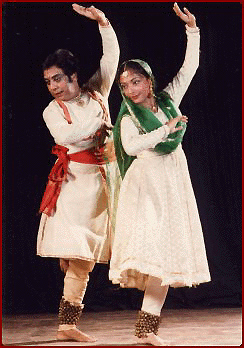The Miracle Plays of Mathura - Part 6
BY: SUN STAFF

Nov 23, CANADA (SUN) — In his book, The Miracle Plays of Mathura, author Norvin Hein describes the performances of an expert troupe of kathak dramatists he studied in Mathura.
"The kathak performance was divided into two parts. The first consisted of fifteen minutes of pure dance (nritya) performed to instrumental music only. Mimetic elements occurred in the dance only in a few momentary pauses during which he would strike a well-known pose such as the of Krishna playing the flute or upholding Mount Govardhan.
This period of dance was broken into sections by intervals in which the kathak would retreat to a corner of the floor, stand motionless for a few moments, and recite rhythmically in a low voice an apparently meaningless series of syllables called a bol. This is a regulative device which governs the timing of the steps in the following section of the dance. It is uttered aloud so that the drummer can learn the pattern of rhythm and tones that is being requested. The task of the drummer is extremely exacting, and there are few musicians who can discharge it satisfactorily. One of the bols used during the performing of the nritya on this occasion was:
tak dhilang, tak dhilang, jhidakit jhidakit jag jag
thum thum thari thari tharrak thei
tatat tat tigada dig dig thei
tigada dig dig thei, tat thei, tran thei
Asked to explain in detail the meanings conveyed by this bol, the kathak smiled and invited the author to study under him intensively for at least six months. For attempts to explain the technicalities of the dance, the reader is referred to the works of La Meri, Popley, and Ambrose, who penned some of the only detailed descriptions available in publication. After prescribing a rhythm in syllables like those above, the kathak would step forth to express it in bodily motion. The bare feet are kept close together; the steps are short and quick. The arms sometimes make quite abrupt and angular motions. The waist bends and twists but little. The beauty of the dance consists in the graceful pirouetting of the body and in the delicate manipulations of the hands. It is a pleasing arabesque of motion involving little or no pantomime.
Two little notice has been taken of the second part of the performance, the gat, which employs an entirely different technique and supplies the story element and the human meaning. La Meri has mentioned gats, which he noticed in the performance of a kathak-trained dancing girl. In intervals of rest, he says, she presented 'in lokadharma, or natural movements and expressions', fragmentary pantomimes on such subjects as a peacock, a gopi, a woman drawing water from a well, or Krishna playing his flute. The few writers who notice the gat at all do not indicate the elaborateness and sophistication of these narrations as they are performed by Nand Kisor.
When the time came for the gat in the performance in the Temple of Anandi Bai, Nand Kisor seated himself cross-legged on the floor. This part of the recital was therefore not a dance at all, properly speaking. Its substance was an extended song uttered in words, and at the same time illustrated and explained it by imitative and symbolic gestures that provided a visual commentary on the text, like the illuminations of a manuscript.
On that February evening, in the Hindu month of Phalgun, the song rendered was a Holi song written by Binda Din. In it, the gopis complain that Krishna has splashed them with colored water, yet they betray their secret love for him. On many nights of the year, Nand Kisor uses the seasonal songs contained in the temple's great book of hymns, which lay open on a low stand before the harmonium.
Hindola (swinging songs) prevail during the rainy month of Sravan, and during the month of Bhadon, the month of the Janmashtami celebration, songs of congratulation to Nand and Yasoda upon the birth of Krishna are in order.
In our next segment, we will explore a wonderful kathak song famously performed by Nand Kisor. Along with the original Sanskrit and translation to this beautiful song about Krsna's exploits, we'll offer a detailed description of the hand mudras and facial gestures that accompany it."
